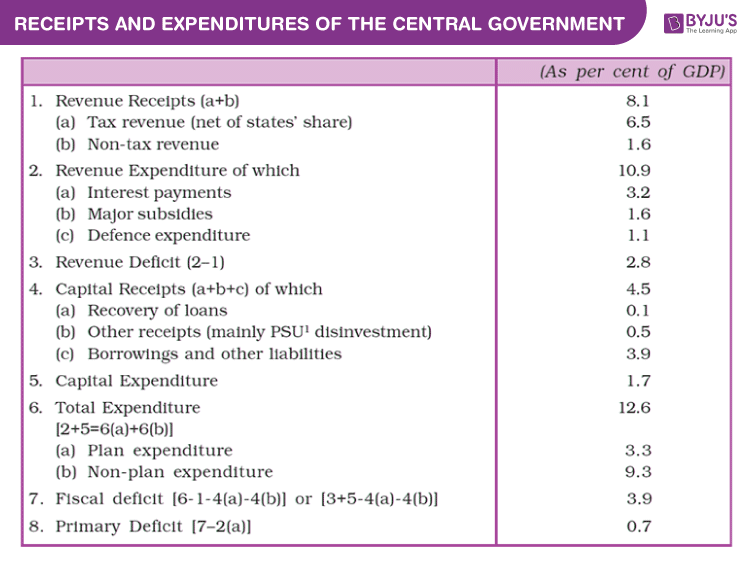Expenditure definition
Expenditure is referred to as the act of spending time, energy or money on something. In economics, it means money spent on purchasing any goods or services.
There are two categories of expenditures which are:
- Revenue Expenditures
- Capital Expenditures
Revenue Expenditures
Revenue expenditures are the expenditures incurred for the basis other than the creation of physical or financial assets of the central government. These are associated with the expenses incurred for the normal operations of the government divisions and various services, interest payments on debt sustained by the government, and grants given to state governments and other parties (even though some of the endowments might be meant for the creation of assets).
Budget documents allocate total expenditure into plan and non-plan expenditures. These are shown in item 6 on the table within revenue expenditure, a distinction is made between plan and non-plan. According to this categorisation, a plan revenue expenditure is associated with central plans (the Five-Year Plans), and central aid for state and union territory plans.
Non-plan expenditure, the more significant component of revenue expenditure, covers a broad degree of general, economic, and social services of the government. The main objects of a non-plan expenditure are interest payments, defence services, subsidies, salaries, and pensions.

Capital Expenditures
There are the expenditures of the government that result in the creation of physical or financial assets, or depletion in financial liabilities. This incorporates expenditure on the investment of building, land, equipment, machinery, investment in shares, and loans and advances by the central government to state and union territory governments, Public Sector Undertakings (PSUs), and other parties.
Capital expenditure is also classified as plan and non-plan in the budget documents. A plan capital expenditure, like its revenue equivalent, is associated with central plan and central assistance for state and union territory plans. A non-plan capital expenditure covers different general, social, and economic services furnished by the government.
The Medium-term Fiscal Policy Statement sets a 3-year rolling target for specific fiscal indicators and examines whether revenue expenditure can be financed through revenue receipts on a sustainable basis and how productively capital receipts market borrowings are being consumed.
The Fiscal Policy Strategy Statement sets the preferences of the government in the fiscal sector, examining current policies and justifying any deviation in important fiscal measures. The Macroeconomic Framework Statement assesses the prospects of the economy for the GDP growth rate, the fiscal balance of the central government, and external balance.
| Q.1 Distinguish between revenue expenditure and capital expenditure. | ||
| Answer: | ||
| Parameters | Revenue Expenditure | Capital Expenditure |
| Meaning | Revenue expenditure refers to the expenditure that neither creates assets nor reduces the liability of the government. | Capital expenditure refers to the expenditure that either creates an asset or reduces the liability of the government. |
| Nature | They are regular and recurring. | They are irregular and non-recurring. |
| Term | Short-term | Long-term |
| Example | Payment of salaries, maintenance of roads, street lights, etc. | Repayment of loans, purchase of machinery, etc. |
| Q.2 Giving reasons identify the following as revenue expenditure or capital expenditure.:
(a) Salary paid to army officers (b) Loan given to union territories (c) Pension paid to retired government employees (d) Interest paid on national debt (e) Repayment of loan taken from the World Bank |
|
| Answer: | |
| (a) Salary paid to army officers | Revenue expenditure
Reason: It neither creates any asset nor reduces the liability of the government. |
| (b) Loan given to union territories | Capital expenditure
Reason: It increases the assets of the government. |
| (c) Pension paid to retired government employees
|
Revenue expenditure
Reason: It neither creates an asset nor reduces the liability of the government. |
| (d) Interest paid on national debt
|
Revenue expenditure
Reason: It neither creates an asset nor reduces the liability of the government. |
| (e) Repayment of loan taken from the World Bank | Capital expenditure
Reason: It reduces the liability of the government. |
| 1 mark questions |
| Q.1. What is meant by capital expenditure? |
| Answer:
Capital expenditure refers to the expenditure that either creates an asset or reduces the liability of the government. |
| Q.2. Give two examples of capital expenditure in a government budget. |
| Answer:
Construction of metros and dams, and repayment of loans to IMF |
| Q.3. Define revenue expenditure. |
| Answer:
Revenue expenditure refers to the expenditure that neither creates an asset nor reduces the liability of the government. |
| Q.4. Give two examples of revenue expenditure in a government budget. |
| Answer:
Payment of salaries by the government, and maintenance of street lights and roads |
|
Receipts |
Expenditure |
||||
| Revenue receipts | Capital receipts | Revenue expenditure | Capital expenditure | ||
| Creates liability | No
E.g., Income tax |
Yes
E.g., Borrowings |
Reduces liability | No
E.g., Payment of salaries |
Yes
E.g., Repayment of loans |
| Reduces assets | No
E.g., Sales tax |
Yes
E.g., Disinvestment |
Creates assets | No
E.g., Payment of pension |
Yes
E.g., Purchase of machinery |
The above mentioned is the concept that is explained in detail about Classification of Expenditure for the class 12 students. To know more, stay tuned to BYJU’S.
It’s a good experience